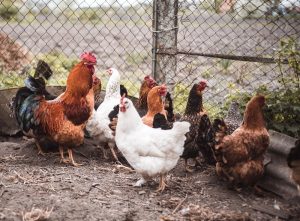I first met Kari Davidson on a plane ride from Iceland to London last summer. After 48-hours awake, I was determined to use the flight to finally catch some sleep before my two months of travel throughout Europe began. Instead of sleeping, Kari and I spent the next three hours engaged in deep conversation. She was also a single, female traveler from the states about to embark on her own six-month journey through Europe and Asia. When we landed in London, I knew I had not only made a travel buddy, I had met an incredible person who was changing the world.
Kari is the creative director and co-founder of Seattle-based nonprofit Haiti Babi. Haiti Babi sells stylish 100% cotton machine-washable baby blankets (and, soon, hats) handmade by Haitian women. Visit their beautifully designed website and you will see a few important lines: Buy a blanket, empower a Mom; Keep families together; It’s more than a blanket, it’s a story. The nonprofit’s goal is to empower moms in Haiti by offering them fair-wage jobs creating baby blankets for other moms around the world. The women who are employed by Haiti Babi earn a paycheck that helps them pull their family out of poverty as well as build their self-esteem and set an example for the next generation.
How did Haiti Babi begin?
My business partner Kaitlin Jackson and I both attended a social enterprise startup weekend. Kaitlin had recently returned from volunteering in an orphanage in Haiti and was hoping to change one of the more heartbreaking things she witnessed. During her work, Kaitlin fell in love with an orphan named Sterly. She felt this desire to adopt, or give him money, or do something to help him. When she realized that he had a family who loved him, and that the only reason he was in an orphanage was that they could not afford to take care of him, it was heartbreaking. She helped them with food before leaving, but quickly realized that she fixed nothing. The problem was just going to continue because they didn’t have work or income to care for their children. Kaitlin knew the best long-term, sustainable solution was to employ the orphans’ mothers. We started to put Haiti Babi together that weekend.
I think for us personally, when we understood how many similar situations as Sterly’s there are in Haiti, that eight percent of kids in Haitian orphanages have at least one living parent, we wanted to find a more sustainable solution for that larger problem. We realized that if we make change in the parents’ lives, it could impact the child’s life, long term.
We knew we needed a skill that required little-to-no prior education and was teachable. Handskills, specifically knitting crochet, were the answer. Selling hand-made baby blankets became the product. A month later, we were on a plane to Haiti.
How many women do you currently employ? Are they all mothers?
We employ ten women and they are all mothers. They have all been identified by our production manager as people who are in the category of being at-risk for having to give up their children or in the past have had to give up their children.
Do any of the mothers currently have children in orphanages?
Last week we hired a new woman who has her daughter in an orphanage. The rest of the mothers have all gotten their children back home.
How long until she will be able to afford to get her daughter out of the orphanage?
She wants to be set and on her feet to ensure that she can keep her for good. It depends how fast she picks up the skill, how she does with the working environment, and how she emotionally feels with her stability. Typically training lasts about two to three months and so, my guess is she will leave Angelee in care during this stage.
Who teaches the mothers how to knit?
Our production manager, Magalie. She’s a super kick-ass Haitian women who was teaching at a sewing school before we taught her how to make the Haiti Babi products. Magalie was our first hire. She came to our interview in an all-pink suit that she had sewn herself. Although crochet is a skill in Haiti none of the women knew how to do it before coming to work for Haiti Babi.
Haiti is the poorest country in the Western Hemisphere and is mostly known for that. What can you tell us about Haiti that most people wouldn’t know?
That it’s beautiful. The beaches are beautiful. Although it is a community that deals with abject poverty, not just a life below the poverty line, but a person unable to live with dignity, it is a really beautiful culture in the sense that the women we work with are extremely loving, community-driven, and supportive.
Is that typical of Haitians or just the Haiti Babi moms?
It’s typical of Haiti in general. There is dance, there is music, there is good food. Our women didn’t used to sing at work. It has been incredible to watch. Now there is always laughing and music. The people who sing and dance are the ones who have energy left to do that, though.
Haiti Babi is now in its second year. What is one of the greatest lessons you have learned from it?
I’ve gained an appreciation. There’s so much that we take for granted on a daily basis. But I think the bigger lesson is that, when I first came home, there was this huge appreciation without an understanding of how to fit it into my daily life. How do I not feel guilty about eating a big, expensive meal? How do I rectify these complex worlds I now live in both of without feeling guilty? I had to recognize that every single person you meet is fighting their own battle and, whether it’s because they grew up in an orphanage or they had family trouble when they were younger, everyone has a complex story. Maybe for different reasons and on different scales, but everyone has struggles that ebb and flow. I have learned to appreciate that and look for it in people. To not jump to conclusions on what they did or did not have to deal with.
When I came back from my first trip to Haiti, after having held a two-and-a-half-year-old that weighed twelve pounds, the small complaints from my friends were suddenly challenging for me to understand and feel compassionate about. But that wasn’t helpful to me or helpful to my happiness or contribution to the society that I live in here. There are elements that are more challenging for these women in Haiti, but there are also a lot of complex challenges that happen in the United States. And not just in the United States, but in lives that are seemingly “easier.” It’s something that took me a while to realize. It just can’t be simplified to a surface-level, “You don’t have this this this and this, therefore your life is much worse and much harder and less-than.” Everyone needs help and support and love for different reasons and in different times. We’ve all needed help. I’ve needed help, that’s for sure.
How often do you travel to Haiti?
Not enough. I’ve been three times and my business partner has been ten times.
Do you have any full-time American employees in Haiti?
Yes, our operations manager, who is fantastic. Her name is Sara. She handles most of the logistics and operations–the payroll, coordination of our shipping, dealing with growth, and implementing new structures for things like financial training that we’re trying to implement with the mothers right now. She’s been there for a month and a half and she’ll be there for a year total.
Where does your funding come from?
Mostly through donors. Ideally, in the long run, our funding will be completely through sales of our product. In this growth phase, we don’t have investors in the same way that a typical for-profit company would have to be able to grow. The finances for growth are coming from donations. We did a Kickstarter Project, we got funding from the University of Washington business school, and we do a big fundraiser every May.
Is there a way for people to donate?
Yes. We take donations on our website and, of course, you can buy the products on our website.
Where do you see Haiti Babi being in five years?
I would love it if we could have Haiti Babi work environments all over Haiti. Right now we’re only in Northern Haiti in Cap-Haïtien. When most people think of Haiti they think of Port Au Prince and the earthquake. Cap-Haïtien was unaffected by the earthquake, but it has struggled with rural poverty for a long time.
It’s challenging—there are a lot of finances and effort going into helping Haiti, but in situations with orphanages, money is being put into the institutions and supporting kids that really need it. But, the negative aspect is that the money is in the orphanages. These mothers feel the need to give their kids nutrition and a chance at a life so they end up giving their kids to the institution where they know they will be taken care of. Bandaid solutions are necessary because of the extreme poverty that exists in Haiti, but at the same time, there’s not enough support for individuals and helping them get out of the extreme poverty. Many places are trying to do work similar to our, but when they’re already dealing with an overcapacity of children that they’re trying to care for, it’s challenging for them to put as much effort into making changes in the families lives. They’re dealing with extreme immediate need.
Haiti Babi will hold its annual fundraiser at 5:30 pm on Saturday, May 10 in Seattle, Washington at The Impact Hub. Products can be bought and donations can be made at HaitiBabi.org.
photo courtesy of Haiti Babi.

















